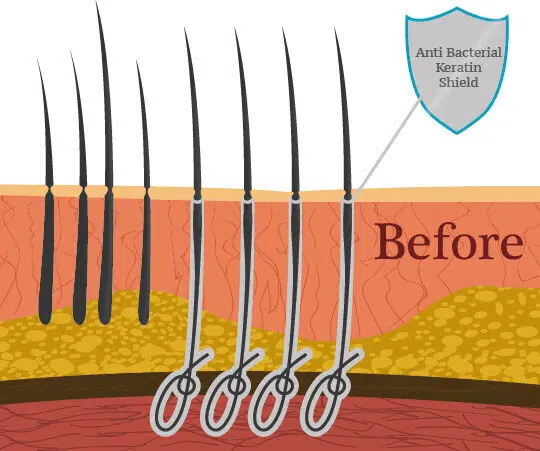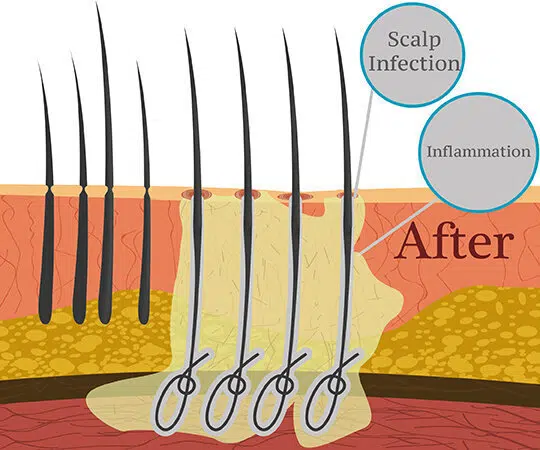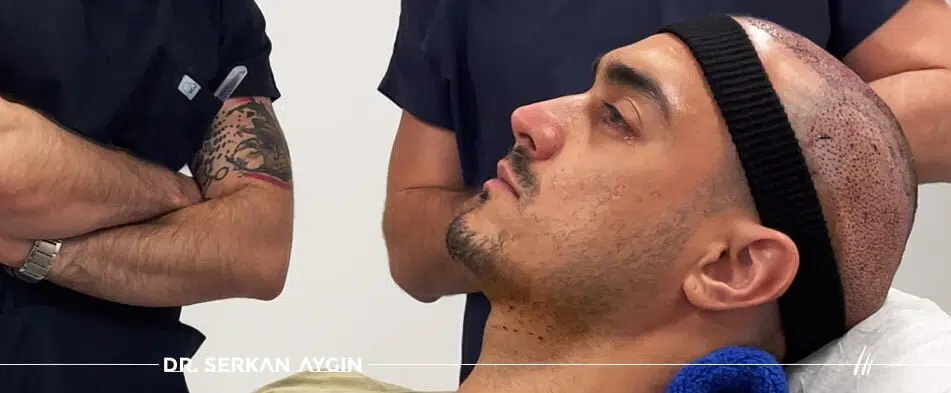Artificial hair transplants created a tremendous impression when it was first introduced in the late 70’s. In this article we will start by reviewing the main aspects of an artificial hair transplant and then provide details on how the procedure is performed.
Before we proceed, we would like to emphasize that the ‘artificial hair transplant’ method we will be covering in this article does not refer to the usage of wigs or hairpieces. Hair strands are transplanted one by one just the same way as in a real hair transplant procedure.

 Although improvements have been made since its first introduction, there still remains a major problem with artificial hair transplants that hasn’t been eliminated:
The fact that the body perceives the artificial hair fibers as a foreign substance. In an organic hair transplant procedure, the body recognizes that the tissue belongs to the person thus, no rejection as well as immune reaction occurs. Another important aspect about hair transplants with biological or semi-biological artificial hair being used, is the fact that the wound channel in which the artificial hair is inserted cannot heal properly, which means that there is consistently an open entrance from the outside, creating an ideal environment for bacteria and other microbes.
This, in turn, causes the body to form a persistent immune reaction that inevitably leads to infections and inflammation in the scalp.
Although improvements have been made since its first introduction, there still remains a major problem with artificial hair transplants that hasn’t been eliminated:
The fact that the body perceives the artificial hair fibers as a foreign substance. In an organic hair transplant procedure, the body recognizes that the tissue belongs to the person thus, no rejection as well as immune reaction occurs. Another important aspect about hair transplants with biological or semi-biological artificial hair being used, is the fact that the wound channel in which the artificial hair is inserted cannot heal properly, which means that there is consistently an open entrance from the outside, creating an ideal environment for bacteria and other microbes.
This, in turn, causes the body to form a persistent immune reaction that inevitably leads to infections and inflammation in the scalp.
Candidates For An Artificial Hair Transplant
Artificial hair transplants have been developed to present an alternative treatment, holding great promise for people who were unable to undergo a real hair transplant due to reasons such as; insufficient donor hair in the back of the head or body as well as health conditions. The term ‘bio fiber’ is now commonly associated with the artificial hair transplant method. Artificial hair transplants that have been presented as a significant alternative to a real hair transplant, due to the complications associated with the procedure such as; infections, cyst formation and inflammation, has been kept under review by some countries. The procedure was first banned in 1983 in North America by the Food and Drug Administration (FDA). After North America other countries also banned the procedure. Today, some clinics still offer artificial hair transplants, stating that they have made improvements by developing fibers that have more biological compatibility.Artificial Hair Transplant Procedure
Also known by names such as synthetic and bio fiber hair transplant; an artificial hair transplant procedure is the process of transplanting artificial fibers that are available in different colors, with different lengths as a substitute for a person’s own hair follicles. As this procedure involves risks, it is important to assess the patient’s suitability and to perform several medical tests in order to proceed. The next step is to observe the body’s reaction to the artificial hair; every one week over a period of at least one month, a small number of implant tests must be conducted before larger sessions can be performed. The patient can only undergo an artificial hair transplant if he/she passes the tolerance tests. Artificial hair transplants are performed using hair strands made from polyamide fibers. The transplantation process is conducted under local anesthesia by utilizing an implanter pen. The implanter inserts the synthetic hair strand into the scalp to a depth of about 0,3 mm. In this respect, it resembles the DHI hair transplant method. In common with the DHI method, during the transplantation process, the micro channels are opened one at a time using an implanter. The insertion of bio fibers are stabilized by a knot that is placed under the scalp. After the transplantation process, as the body tries to close the wound channel by growing new connective tissue, it also fills into the loop of the synthetic fibers. As a result, the artificial hair will be more strongly secured in the scalp.The Complications Associated With Bio Fiber Hair Transplants

 Although improvements have been made since its first introduction, there still remains a major problem with artificial hair transplants that hasn’t been eliminated:
The fact that the body perceives the artificial hair fibers as a foreign substance. In an organic hair transplant procedure, the body recognizes that the tissue belongs to the person thus, no rejection as well as immune reaction occurs. Another important aspect about hair transplants with biological or semi-biological artificial hair being used, is the fact that the wound channel in which the artificial hair is inserted cannot heal properly, which means that there is consistently an open entrance from the outside, creating an ideal environment for bacteria and other microbes.
This, in turn, causes the body to form a persistent immune reaction that inevitably leads to infections and inflammation in the scalp.
Although improvements have been made since its first introduction, there still remains a major problem with artificial hair transplants that hasn’t been eliminated:
The fact that the body perceives the artificial hair fibers as a foreign substance. In an organic hair transplant procedure, the body recognizes that the tissue belongs to the person thus, no rejection as well as immune reaction occurs. Another important aspect about hair transplants with biological or semi-biological artificial hair being used, is the fact that the wound channel in which the artificial hair is inserted cannot heal properly, which means that there is consistently an open entrance from the outside, creating an ideal environment for bacteria and other microbes.
This, in turn, causes the body to form a persistent immune reaction that inevitably leads to infections and inflammation in the scalp.
Some Other Complications
- As transplanting in areas with very thin dermal tissue is strictly avoided, patients who are seeking coverage within the respective areas, cannot undergo a bio fiber hair transplant. These areas refer to the temples and low frontal hairline.
- Patients are at an increased risk of experiencing apparent inflammation (infections) on the skin. This, in turn, will lead to scar formation that will appear aesthetically unpleasant; leaving the skin with a rough and uneven skin texture.
- Approximately 15-20% of the transplanted artificial hair fibers fall out every year. For this reason, the transplanted hair will not remain permanent as natural hair. Additional hairs have to be transplanted every year.
- Even though the life cycle of transplanted artificial hair strands differ from one another, the estimated life span is considered to be around 8 to 10 years. The determining factors of the life span is also linked to the body’s reaction to the artificial hair.
- As factors such as heat (hairdressers, blow dry) and chemicals applied (hair stylers) are more likely to cause damage to the artificial hair, it needs to be treated with extra care.
- Inflammatory reactions such as infections and acne may occur.
- While the body may seem to have accepted the transplanted artificial hair fibers at the beginning, there is the likelihood of rejection after some time. In such a case, the transplanted artificial hairs must be removed.
- The synthetic hair strands that have been rejected by the body, can cause permanent damage to the skin.
- If a person who has undergone a bio fiber hair transplant has developed such an infection on the skin, unfortunately it is not possible to perform an organic hair transplant on the same area.
